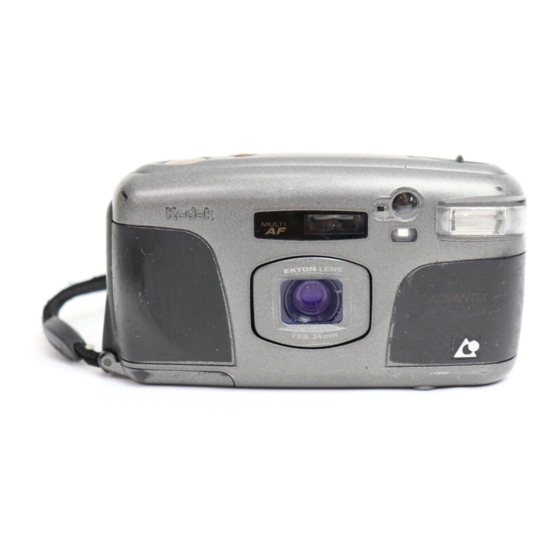Table of Contents
Advertisement
Quick Links
Advertisement
Table of Contents

Summary of Contents for Kodak Advantix 3600ix
- Page 1 3600 Camera...
- Page 2 Film Status Indicator (FSI) A highlighted indicator advances from one symbol to another to identify the status of the film inside the cassette. Look for this logo to be certain that the film you buy is made for this camera. Look for this logo to select a certified photofinisher for developing your film and to assure that you get all the features of the...
- Page 3 (10) (21) (20) (19) (16) (18) (30) (17) (11) MENU SELECT LEFT ENTER OPEN (15) (22) (23) OFF FILL (24) (28) (29) (26) (25) (27) (12) (13) (14)
- Page 5 Need help with your camera or more information about the new Advanced Photo System? Call Kodak (United States only) toll free from 8:00 a.m. to 8:00 p.m. (Eastern time) Monday through Friday at 1 (800) 242-2424. The toll free number (in Canada only) from 8:30 a.m. to 5:00 p.m. (Eastern time) Monday through Friday is 1 (800) 465-6325;...
-
Page 6: Camera Identification
CAMERA IDENTIFICATION See inside cover flaps of manual for camera diagrams. (1) Shutter Button (2) On/Off Button (3) Meter-Cell Window (4) Print-Size Selector (5) Self-Timer/Focus-Ranging Assist/Red-Eye-Reduction Lamp (6) Flash (7) Battery Door (8) Viewfinder (9) Lens (10) Focus-Ranging Sensors (11) LCD Panel (12) Menu Button (13) Select/Flash Button (14) Enter/Self-Timer Button... -
Page 7: Loading The Film
BATTERY This camera uses a 3-volt lithium KODAK KCR 2 (or equivalent) Battery that supplies power for all camera operations. This camera automatically turns off after 4 minutes. Battery Indicator When the battery symbol (24) “blinks,” you will need to replace the battery soon. When the battery symbol is solid (non-blinking) and the shutter button does not operate, replace the battery immediately. -
Page 8: Setting The Date And Time
SETTING THE DATE AND TIME With this camera, you can record the date and time of each exposure directly onto the film. The information appears on the back of your prints when processed. It features a clock and automatic calendar that includes leap years. 1. -
Page 9: Taking Pictures
TAKING PICTURES You can take Classic (C), HDTV (H), and Panoramic (P) pictures on the same film cassette (see following table for Typical Print Sizes). Your photo-processing cost will be based on the format size(s) that you use to expose the film. 1. - Page 10 Using the Focus Lock This camera automatically focuses on whatever is within the auto-focus circle of the viewfinder eyepiece (16). To get a sharp photograph, make sure the auto-focus circle is on your main subject. If you want to take a picture with the subject positioned outside of the auto-focus circle, use the focus lock as follows: 1.
- Page 11 Using the Self-Timer 1. Use a tripod (tripod socket [18]) or place the camera on another firm support. 2. Press the on/off button (2), 3. Press the enter/self-timer button (14) to the self-timer (25) position. 4. Press the shutter button (1). The self-timer lamp (5) will “blink” 10 seconds before the picture is taken.
-
Page 12: Taking Flash Pictures
TAKING FLASH PICTURES In dim light, such as indoors or outdoors in heavy shade or on dark overcast days, you need flash. Your camera features automatic flash that fires when you need it. It also provides automatic daylight fill flash under certain bright-light conditions where shadows may exist. - Page 13 Flash-to-Subject Distance ISO Film Speed 1600 Flash Tips • Turn on room lights and have the subject face the lights to minimize red eyes in pictures. • Stand at an angle to shiny surfaces like windows or mirrors to avoid flash reflection and bright spots in your pictures.
-
Page 14: Unloading The Film
Using Fill Flash, Off Flash, and Red-Eye Reduction Fill Flash — Bright light indoors or outdoors from backlit subjects can create dark shadows (especially on faces) in high-contrast scenes. Use fill flash to lighten the shadows. Off Flash — When you do not want to use the flash, especially indoors where flash is prohibited, such as in theaters and museums, or in dim lighting situations, use off flash. -
Page 15: Troubleshooting
Replace or reload the battery (see Solution above) Load another film cassette into camera Call Kodak for assistance Load only unexposed film into the camera Press shutter button, turn the camera off and on, or replace... - Page 16 Apertures: f/ 3.6, f/ 7.2, f/ 14.4 Shutter: Programmed electronic; speeds from sec. Power Source: one 3-volt lithium KODAK KCR 2 (or equivalent) Battery; auto power off after 4 minutes Dimensions: Approx. 1.5 x 2.5 x 4.7 in (38 x 63 x 119 mm) Weight: Approx.
- Page 17 Consumer Imaging EASTMAN KODAK COMPANY Rochester, NY 14650 © Eastman Kodak Company, 1997 1-97 Printed in U.S.A. Pt. No. 916 3833...











Need help?
Do you have a question about the Advantix 3600ix and is the answer not in the manual?
Questions and answers